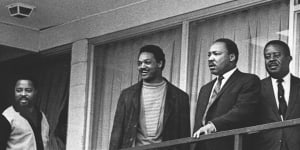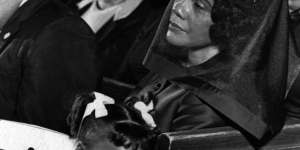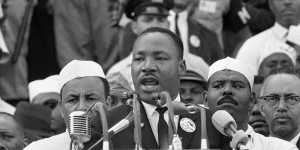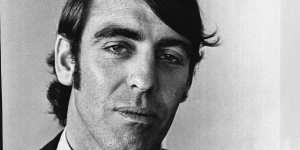The man of peace who died by violence
By Don Riseborough in New York
TO MILLIONS of Americans,both black and white,the Rev. Dr. Martin Luther King was a man who preserved the bridge of communication between races when racial warfare threatened the city,the State and the country in the ’60s.

Rev. Martin Luther King Jr.,second from right,standing with other civil rights leaders on the balcony of the Lorraine Motel in Memphis,Tenn.,a day before he was assassinated at approximately the same place.(AP Photo/Charles Kelly,File)
To the Negro especially,he was the prophet of their crusade for racial equality,their voice of anguish,and their battle cry for human dignity.
He forged for them the weapons of non-violence that withstood,and blunted,the ferocity of segregation. He cried to them:“I will not be satisfied until segregation is dead in America,” and they listened and followed.
To the world Dr King had the stature of a man who was a winner of the Nobel Prize - only the third member of his race to do so;a man with access to the White House and the Vatican;a hero in the African States that were just emerging from colonialism.
At the time of his assassination in Memphis,Tennessee,he was facing the challenge of his career as the leading nonviolent spokesman of this generation on the issue of equal rights.
He was involved in a plan to dramatise the plight of the poor and stir Congress to help Negroes.
He called this venture the “poor people’s campaign” and he planned to take thousands of poor people,most of them Negroes,to “camp-in” in Washington later this month.
Dr King was in Memphis to raise the plight of the 1,300 striking city garbage collectors.
Last week he staged a march which erupted into the first racial disturbance of the year,with young Negroes looting and rioting. This Monday he planned to lead a second march.
In one of his last public speeches Dr King told an audience in a Harlem church on March 26:“We need an alternative to riots and timid supplication. Non-violence is our most potent weapon.”
His present drive could be described as an “anti-riot” drive.
He said often that he was working to save the nation by showing Negroes that nonviolence could work,could get results for them in their economic plight.

Coretta Scott King and her daughter,Bernice,attending the funeral of her husband,Martin Luther King,on April 9,1968. (AP Photo/Moneta J. Sleet,Jr.)
But as an advocate of nonviolence Dr King stood in the crossfire between white and Negro extremists as the racial tensions in many of America’s cities erupted into arson,gunfire and looting in the summer of 1967.
Symbol
Militant Negroes,those who claimed black power and cried “Burn,baby,burn,” argued that only by violence and segregation could the Negro attain self-respect and real equality.
White extremists looked upon the Civil Rights leader as one of their chief enemies.
Inevitably,as a symbol of integration,he became the object of unrelenting attacks and vilification.
His home was bombed;he was spat upon;he was struck and kicked;he was stabbed,almost fatally,by a deranged Negro woman;he was frequently thrown into gaol.
His passive disobedience through all these trials and tribulations infuriated segregationists.
The Negro extremists he criticised dismissed his passion for non-violence as another form of servility to the white people.
They called him an “Uncle Tom” and said he was hindering the Negro struggle for equality.
But from ministers to garbage men,businessmen to disc jockeys,Dr King contacted a wide spectrum of groups. And to all he preached nonviolence and white participation in the Civil Rights movement.
His aims were to rebuild the faltering and factionalised Negroes without alienating Whites.
In his “I have a dream for America” speech in 1963,Americans,both black and white,were deeply stirred,when he said:“Even though we face the difficulties of today and tomorrow,I still have a dream. I have a dream that one day this nation will rise up and live out the true meaning of its creed ‘we hold these truths to be self-evident that all men are created equal.‘”

In this Aug. 28,1963,file photo,Dr. Martin Luther King Jr. addresses marchers during his “I Have a Dream” speech at the Lincoln Memorial in Washington.AP Photo,File
Martin Luther King was born on January 15,1929,in Atlanta,Georgia. His father was a Baptist minister.
Young Martin went to Atlanta’s Morehouse College and then went on to take a Bachelor of Divinity degree from Crozier Theological Seminary,in Chester,Pennsylvania.
He was ordained a minister in his father’s church in 1947. Some years later he was to say in this same church:“America,you’ve strayed away. You’ve trampled over 19 million of your brethren. All men are created equal. Not some men. Not white men. All men. America,rise up and come home.”
In 1954 Dr King became pastor of the Dexter Avenue Baptist Church in Montgomery,Alabama,where he became devoted to the task of seeking equal rights for all America’s Negroes.
Assault
On December 1,1955,in Montgomery,a tired Negro seamstress,Mrs Rosa Parks,refused to give up her bus seat for a white person. She was arrested and fined 14 dollars. The incident sparked off a wave of discontent among Negroes in the city.
Foremost among the many Negro leaders in the city who rallied to help Mrs Parks was Martin Luther King.
From a protest begun over a Negro woman’s tired feet,Dr King began his public career.
He launched his most massive assault on the barricades of segregation at Birmingham in 1963,where he announced he would lead nonviolent demonstrations in Birmingham “until Pharoah let’s God’s people go.”
The Alabama riots of 1965 were a result of hundreds of Negroes,led by Dr King,walking through the streets demonstrating.
Dr King marched determinedly through Selma despite court injunctions,police resistance,shootings,beatings,and other violence. It turned Selma into a bloody centre of racial antagonism.

Don Riseborough,New York Office Staff. December 16,1969.Staff photo
Yet there was little of the rabble-raiser in the Baptist minister’s oratory. He was not prone to extravagant gestures or loud perorations. He had none of the flamboyance of Harlem’s Adam Clayton Powell,or the cool strategic brilliance of Roy Wilkins,head of the National Association for the Advancement of Coloured People.
What Dr King did have was an instinct for the right moment to make his moves. Some critics looked upon this as pure opportunism.
He was a master organiser and demonstrator and he dramatised the plight of the Negro in the South as had never been done before. He made racism in the South come alive.
Love
He abhorred the violent methods of the Negro in the North. Following the disastrous Detroit riots of last year in which more than 40 people were killed,he said:“As I look at my brothers and sisters in the cities,I must say ‘this is not the way.’ A riot does more harm to Negroes than to anyone else.
“I’ve decided to stick with love. Hate is too great a burden to bear.”
While trying to bridge the gap between white and black,Dr King inevitably created problems with the Whites. While in gaol during the Birmingham demonstrations in 1963,he wrote:
“I have almost reached the regrettable conclusion that the Negroes’ great stumbling block in the ride toward freedom is not the white citizens’ councillor or the Ku Klux Klanner,but the white moderate who is more devoted to order than to justice;who prefers a negative peace,which is the absence of tension,to a positive peace,which is the presence of justice.”
There was no false modesty in Dr King’s self-appraisal of his role in the Civil Rights movement.
“History,” he said,“has thrust me into this position. It would be both immoral and a sign of ingratitude if I did not face my moral responsibility to do what I can in this struggle.”
He knew the dangers involved and the consequences.
And in a small church in Georgia in 1962,he told friends “I may get me crucified. I may even die. But I want it said even after I die in the struggle that ‘he died to make men free’.”